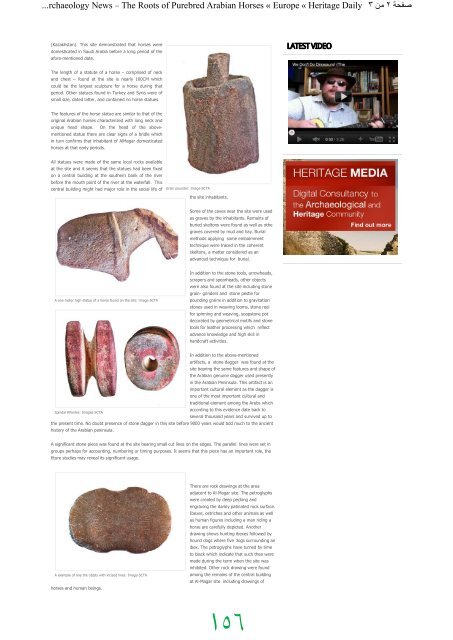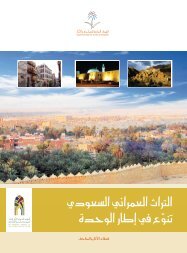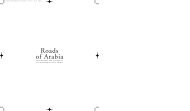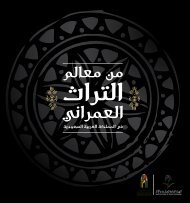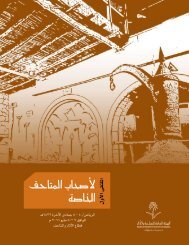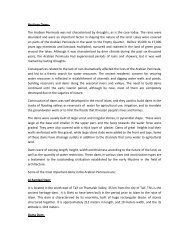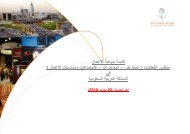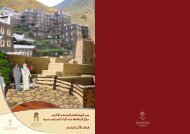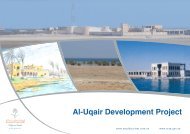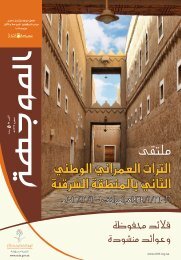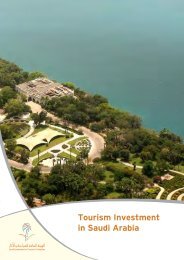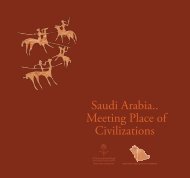ﺧïºØ¯Ù اï»ïº¤ïº®ï»£ï¯¿ï»¦
ﺧïºØ¯Ù اï»ïº¤ïº®ï»£ï¯¿ï»¦
ﺧïºØ¯Ù اï»ïº¤ïº®ï»£ï¯¿ï»¦
Create successful ePaper yourself
Turn your PDF publications into a flip-book with our unique Google optimized e-Paper software.
...rchaeology News – The Roots of Purebred Arabian Horses « Europe « Heritage Daily<br />
156<br />
/ http://www.heritagedaily.com/2011/08/the-roots-of-purebred-arabian-horses<br />
صفحة ٢ من ٣<br />
٣٢/١٠/١١<br />
(Kazakhstan). This site demonstrated that horses were<br />
domesticated in Saudi Arabia before a long period of the<br />
afore-mentioned date.<br />
LATEST VIDEO<br />
The length of a statute of a horse – comprised of neck<br />
and chest – found at the site is nearly 100CM which<br />
could be the largest sculpture for a horse during that<br />
period. Other statues found in Turkey and Syria were of<br />
small size, dated latter, and contained no horse statues.<br />
The features of the horse statue are similar to that of the<br />
original Arabian horses characterized with long neck and<br />
unique head shape. On the head of the abovementioned<br />
statue there are clear signs of a bridle which<br />
in turn confirms that inhabitant of AlMagar domesticated<br />
horses at that early periods.<br />
All statues were made of the same local rocks available<br />
at the site and it seems that the statues had been fixed<br />
on a central building at the southern bank of the river<br />
before the mouth point of the river at the waterfall. This<br />
central building might had major role in the social life of Grain pounder: Image-SCTA<br />
the site inhabitants.<br />
Some of the caves near the site were used<br />
as graves by the inhabitants. Remains of<br />
buried skeltons were found as well as othe<br />
graves covered by mud and hay. Burial<br />
methods applying some embalmment<br />
technique were traced in the coherent<br />
skeltons, a matter considered as an<br />
advanced technique for burial.<br />
A one meter high statue of a horse found on the site: Image-SCTA<br />
In addition to the stone tools, arrowheads,<br />
scrapers and spearheads, other objects<br />
were also found at the site including stone<br />
grain- grinders and stone pestle for<br />
pounding grains in addition to gravitation<br />
stones used in weaving looms, stone reel<br />
for spinning and weaving, soapstone pot<br />
decorated by geometrical motifs and stone<br />
tools for leather processing which reflect<br />
advance knowledge and high skill in<br />
handcraft activities.<br />
In addition to the above-mentioned<br />
artifacts, a stone dagger was found at the<br />
site bearing the same features and shape of<br />
the Arabian genuine dagger used presently<br />
in the Arabian Peninsula. This artifact is an<br />
important cultural element as the dagger is<br />
one of the most important cultural and<br />
traditional element among the Arabs which<br />
according to this evidence date back to<br />
Spindal Whorles: Images-SCTA<br />
several thousand years and survived up to<br />
the present time. No doubt presence of stone dagger in this site before 9000 years would add much to the ancient<br />
history of the Arabian peninsula.<br />
A significant stone piece was found at the site bearing small cut lines on the edges. The parallel lines were set in<br />
groups perhaps for accounting, numbering or timing purposes. It seems that this piece has an important role, the<br />
fiture studies may reveal its significant usage.<br />
A example of one the objsts with incised lines: Image-SCTA<br />
horses and human beings.<br />
There are rock drawings at the area<br />
adjacent to Al-Magar site. The petroglyphs<br />
were created by deep pecking and<br />
engraving the darkly patinated rock surface.<br />
Ibexes, ostriches and other animals as well<br />
as human figures including a man riding a<br />
horse are carefully depicted. Another<br />
drawing shows hunting ibexes followed by<br />
hound dogs where five dogs surrounding an<br />
ibex. The petroglyphs have turned by time<br />
to black which indicate that such thee were<br />
made during the term when the site was<br />
inhibited. Other rock drawing were found<br />
among the remains of the central building<br />
at Al-Magar site including drawings of


